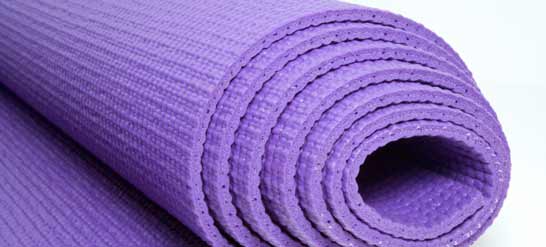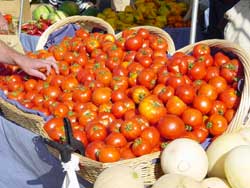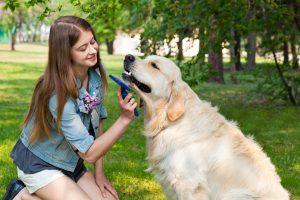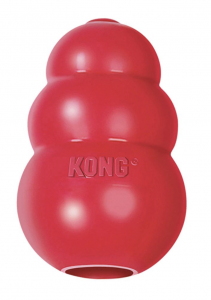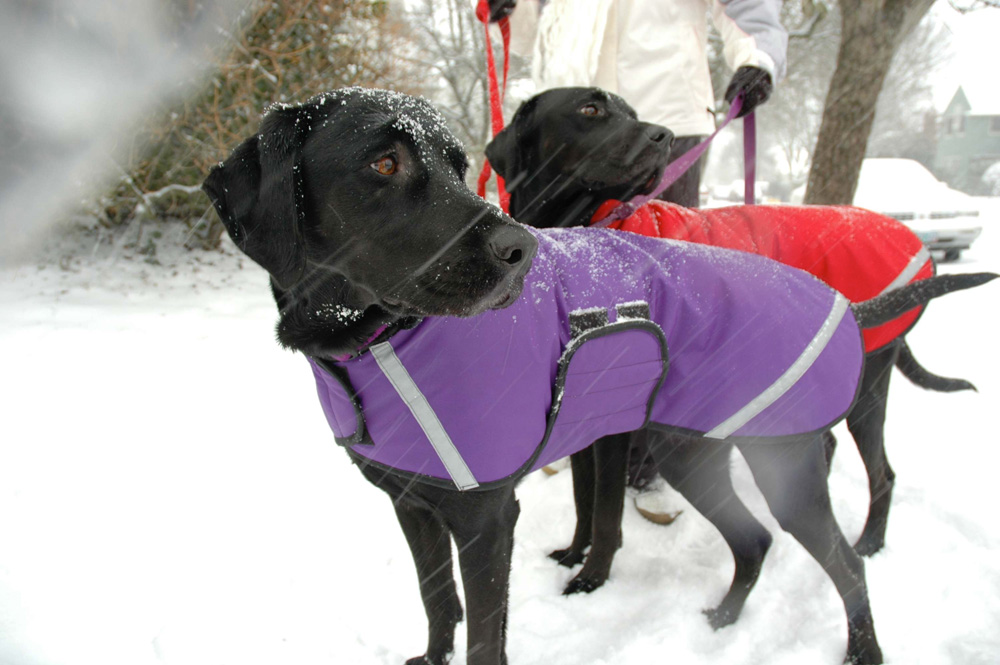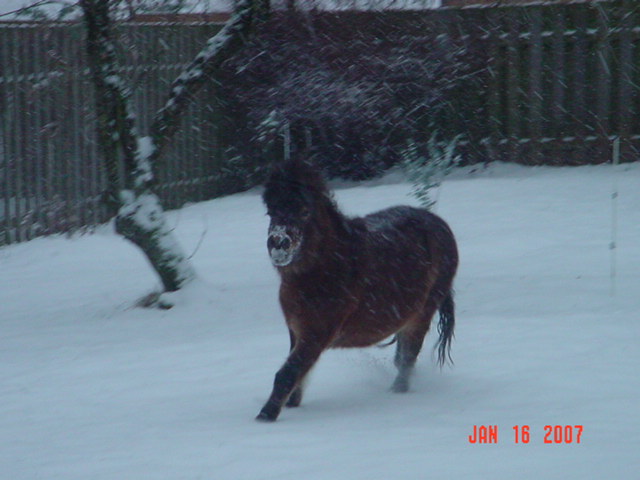
Property of Green Dog Pet Supply, Photo by Christine Mallar
Given the events of the past few weeks (recalls due to pet foods tainted with Melamine from China) , I thought I might publish a few of my old newsletter articles on nutrition to the blog. We believe the best way to feed your pets is with a commercially prepared raw food diet. Our kitty eats a little canned food combined with prepared raw food, as well as pieces of whatever meats we might be preparing for ourselves as treats for her. I’ll tell you, I’ve always known that raw food is great, but she has really driven the point home for me. We got her at two years old,and she’s nearly 20 years old now. She looks far better then when she was 5. Or maybe ever. When she was 18 we thought she was nearing her end. She looked like a really old lady – she was bony and skinny, she’d lost most of the muscle mass in her back end and couldn’t jump up in the window very well any more. Her coat was dull and greasy looking, and her black was looking brown. Not now! She agreed finally to eat raw food, and she’s as glossy as a seal. Her coat is black again and thick and soft and her muscle mass is back, and she’s able to jump up in the window again – she’s gorgeous, and looks better than she did when she was half this age. She also had early stage kidney and liver disease and had a hard lump the size of a Canellini bean on her arm. The time table of changes went like this: within 2 weeks we noticed dramatic improvements in her coat quality. Within 2 months her muscle mass had improved greatly and she was more mobile. Her stiffness was definitely reduced as well. Less than a year later, the lump on her arm was gone, and her blood work showed significant improvement in both her kidney and liver values. She lived to be 22, and was the primary reason we started to be much more conscious of the benefits of raw food. It’s stunning to watch rapid changes happen like that right in front of your eyes! In her last year when she sometimes would refuse her raw food, we’d watch her start to waste away again, and in just the course of a week or two, she’d look very old again and lose weight, and her coat started to look pretty dull again, even though she was eating other things. As soon as she’d agree to eat the raw food again, she’d blossom again, and her coat was shinier and prettier within the week, and her weight would come back just as quickly as well. It’s a testament to the digestibility of the raw food – you could literally see her body better able to heal itself and make repairs. She ate well and looked gorgeous right up to the end, and we know that the Rad Cat raw food added those precious extra years to her life).
A few months ago a little pug named Edgar came in – he was so incredibly cute but clearly had some strange issues going on. He was thin and a little wobbly, and couldn’t take a treat easily as his tongue stuck way out of the side of his mouth making it very difficult for him to chew and swallow. His mom said that he had been to many vets to try and figure it out to no avail. She visited a holistic vet who put him on raw food. You should see him now – he zooms in to the store with incredible vibrancy (no more wobbles!), his coat is glossy and healthy, his eyes are clearer, and his tongue is back in his head where it belongs. It’s amazing.
Just a week ago a regular customer came in understandably upset about her cute boxer, Jake. He has chronic food sensitivities, and has tried just about every kind of kibble, including prescription foods without relief from the terrible itching. We tried him on Duck and Potato most recently and he was doing pretty well on that one for a few months. But, like has happened to him before, eating the same thing every day creates a bad reaction for him. He started itching severely – the poor guy was clawing at his face nonstop. (it makes some sense that a dog with food sensitivities can easily become sensitized to any food – his body decides he’s had too much of that thing and reacts) We decided it was time to try raw food, as it very well may not be any specific protein or grain that he’s allergic to, it may simply be that Jake’s body can’t handle processed food, and he tends to not tolerate a lack of variety. (though he was in the typical catch-22 of not being able to have variety as everything made his skin react). Within 2 days of starting raw food, his skin calmed down and he was able to rest easier. I believe that he will be able to tolerate and benefit from variety, as long as we keep feeding him whole uncooked foods.
We are constantly amazed at the power of real food on the health of animals (and people! The more unprocessed whole foods that we can eat, the healthier we are too). Read more here about what’s happening inside a pet with food sensitivities and what else can help!
At any rate, here’s the raw food article from the newsletter. Please remember that the information in my articles are based on my opinions and are not to be treated as medical advice, or to replace a good one-on-one relationship with a holisitic veterinarian.
Some folks call it the BARF diet — which stands for “Bones and Raw Food”, or for “Biologically Appropriate Raw Food”. What’s it all about?
Of all of the creatures that roam the earth — the carnivores, the omnivores and the herbivores, we humans are the first and only animals to cook the food we eat. Over the past few decades, Americans are eating more and more processed food, and we’re seeing a corresponding rise in many health problems, including diabetes, cancer, etc. We know that whole foods are the most nutritionally complete and that a steady diet of fast food can make us unhealthy pretty quickly. So what about our pets? Do they do best on cooked, processed food? Aren’t they supposed to eat kibble to stay healthy?
Kibble diets are a relatively recent development (compared to how long cats and dogs have lived with humans, or the many thousands of years they’ve hunted for their own foods) and these dry diets were of course developed for convenience. There’s no doubt that the quality of kibble available is improving all the time, and there is also no doubt that a higher quality kibble (with higher quality meat proteins and fewer carbohydrates) results in a healthier dog that sheds less, smells better, and looks shinier than a dog on a grocery store brand. However, like humans in this society, the rate of chronic disease in our pets has risen dramatically. Many holistic vets and nutritionists attribute this to the amount of work the body has to go through to digest these highly processed foods, and the fact that many nutrients, (fragile amino acids like taurine that are very heat sensitive and critical for supporting their hearts, brains and muscle mass) and most if not all digestive enzymes are lost in the cooking process. When a dog comes through our doors that’s eaten raw food and bones their whole lives, we can tell right away. These dogs make you say “WOW”. The shine, the body condition, the gleaming white teeth — these dogs look fantastic.
Cats do especially well on raw food. It makes sense, as feral cats feed themselves quite well on whole rodents and birds. They crunch right through meat, bones and organs, perhaps eating trace amounts of greens/seeds in the stomach contents of their prey. Raw food mimics this perfectly for them. A natural cat diet wouldn’t really contain any carbohydrates at all, while most commercial dry cat foods are heavy with wheat, corn, peas, etc. Some brands have hardly any meat at all, just by-products (waste parts like heads, feet, and entrails – a very inconsistent ingredient due to varying proportions of the contents). Cats have not evolved any metabolic ability to turn carbohydrates into energy, so these carb-heavy diets just create a fat cat that is prone to inflammatory issues, bowel troubles, kidney disease and especially diabetes.
A recent study evaluated the effects of dietary carbohydrates on urine volume, struvite crystal formation, and calcium, phosphorus, and magnesium balance in clinically normal cats. It concluded that diets high in grains stimulate the formation of struvite crystals, and led to a net loss of body calcium, phosphorus and magnesium. 1
Our dogs and cats are very closely related to their wild cousins. Look at the structure of these teeth and compare with their wild counterparts. A house cat is nearly identical on the inside to a tiger or cougar, and our dogs are physiologically very similar to their wold ancestors.
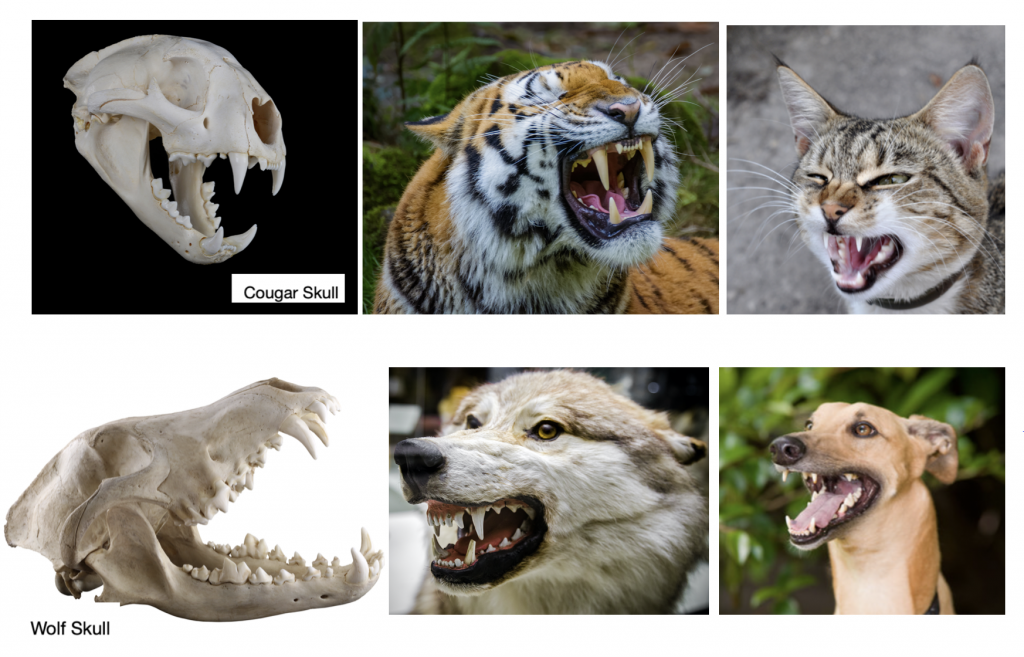
All photos licensed by Adobe Stock photos
What’s different about raw food?
Dogs only manufacture about 25% of the digestive enzymes needed to break down their food — the other 75% is supposed to come from the raw prey they eat. Unfortunately the cooking process destroys these enzymes and a large percentage of their nutrient value. A few of the better kibbles add digestive enzymes after they are cooked, but all dogs on kibble could benefit from the addition of digestive enzymes to their diet (check out this product for dogs and this product for cats). Raw foods have their nutrients and digestive enzymes in tact, meaning the body doesn’t have to work as hard to generate the enzymes needed to break down the food, or filter out the toxins created by the cooking process. In poor quality kibble, there is an added burden on organs like the liver to process the poor quality proteins and fats sources used, and acrylamide is a carcinogenic chemical produced when carbohydrates are heated to high temperatures in the presence of certain sugars. Add to this the presence of chemical preservatives, artificial colors, etc and it’s a lot for the body to handle over the course of a lifetime.We know that we humans who eat only highly processed foods for a lifetime are very prone to chronic health issues, and it’s the same for our pets.
Isn’t it dangerous to feed raw meat?
All meat should be handled carefully, and kept cold from farm to bowl. Dogs and cats do handle bacterial contamination better than we do — especially dogs, who are designed as scavengers as well as predators. (We regularly hear gross stories like the dog last week who ate the bloated decaying rat he found in the yard and was fine, aside from some bad breath.) Pets with immune system deficiencies or those going through chemo may be more susceptible to bacterial contamination, and they might be safer eating dehydrated raw food, as dehydration kills any pathogenic bacteria. (This is also a good tip for those families that have human toddlers in the house that might get into pet bowls).
We would agree with any veterinarian that says you shouldn’t buy raw meat at your grocery store to be fed to pets, as these meats can contain dangerous levels of salmonella, etc as they are meant to be cooked before eaten. However, companies that manufacture prepared raw pet food handle the meat knowing that it will be eaten raw and use extremely clean equipment and keep it even colder from slaughter to store. Most importantly, the FDA has a zero tolerance policy regarding salmonella, and companies know they can be shut down for salmonella contamination. We raw feeders have become comfortable with the concept of raw food diets, we just make sure that the meat is fresh, purchased from a reliable source using practices to prevent and eliminate salmonella, and handled properly. We make sure to keep raw meats refrigerated, we remove uneaten food after mealtime and use clean bowls each time we offer new food, and we also make sure that toddlers aren’t allowed access to food bowls while they are on the floor.
Raw food enthusiasts will tell you that the health risks of feeding processed food far outweigh the risks of feeding raw.
Check out this article, “Claiming Raw Foods Are Dangerous Isn’t Backed Up With Data”
and: Raw Foods Treated Unfairly (again) By The FDA
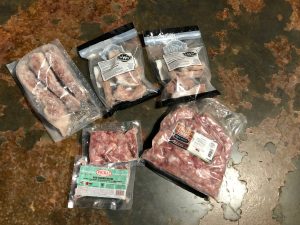
Photo property of Green Dog Pet Supply
Bones are another subject that gets people a bit worried. They are absolutely crucial to include in some form when feeding fresh meat(or at least some sort of calcium supplement should be given), due to nutritional requirements of carnivores (meat and organs alone have too much phosphorus if not balanced by calcium in the diet. This is also true if you’re home cooking meat for your pet – you still need some calcium to make your diet balanced. (see resources below for detailed information).
There are powdered calcium supplements, but Dogs are quite capable of consuming turkey necks, chicken backs and wings, etc. This is surprising to people, as we’ve been told all of our lives that chicken bones are dangerous. It is absolutely true that cooked chicken bones are very dangerous, as the cooking process turns them brittle and splintery. Raw bones are more pliable and safer to eat. (check out this blog post of ours about chicken necks for cats and dogs, with video of our cat crunching them up)
Many people choose to stick to ground bones — your butcher should be able to grind whole chickens for you, and the prepared raw diets we carry already contain ground bone. Pultry necks are absolutely some of the best teeth cleaners you can find, and can keep a dog occupied (Note — we carry raw beef and buffalo marrow bones in three sizes in our freezer for recreational chewing).
Isn’t it difficult to feed raw?
Making your own balanced, complete raw diets takes a bit of research in the beginning, and a bit of extra effort to shop for and prepare. Most folks say that they get the butcher to grind their meat and bones for them, and then spend about an hour or so adding fruits and veggies, portioning and freezing the diets that will last the whole month. Check out great tips here for making balanced meals at home. Some people are still daunted by the project though, and it is very important that their meals are balanced. A homemade diet can be the very best thing you can do for your pet, and also could be the very worst thing you can do if the diet isn’t balanced properly.
The good news is that there are a number of really nice prepared raw foods on the market. We carry several brands in our freezer.
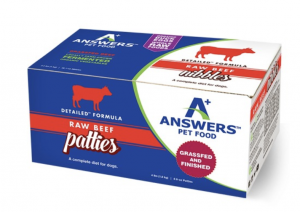
Photo by Answers Pet Food
For example, Answers brand raw foods – here’s the ingredient list for their detailed Beef dog food: Pasture raised and finished beef, beef heart, beef liver, beef kidney, ground beef bone, organic carrots, organic duck eggs, organic green squash, cod liver, organic broccoli, whey, butter, kefir (raw cow milk, dried Lactobacillus bulgaricus fermentation product, dried Lactobacillus acidophilus fermentation product, dried Leuconostoc mesenteroides fermentation product, dried Lactobacillus lactis fermentation product), montmorillonite, organic parsley, salt, vitamin E supplement.Fabulous! We should all eat so well. The fermentation used in these diets also actively protects the food from pathogens like salmonella, allowing it to keep safe from contamination for up to 7 days thawed in the refrigerator.
To sum it up
Dog food companies have spent millions of dollars convincing us that commercial dog and cat food is the ONLY way to feed a pet and that you must feed the same exact kibble for the pet’s whole life. The evidence suggests that it might actually be detrimental to limit a diet so severely, causing deficiencies and food sensitivities. No matter how thoughtfully I created the most healthy meal, I couldn’t come up with a single recipe to feed myself every day of my lifetime without having some sort of nutritional deficiency or excess for me (which may be different for what your body needs). A recent study found that Irish Setters consuming a single food type were three times more likely to develop GDV (bloat) than Irish Setters fed a variety of food types. Inclusion of table foods in the diet of large-breed and giant-breed dogs was associated with a 59% decreased risk of bloat, while inclusion of canned foods was associated with a 28% decreased risk. 2 (meaning variety is important)
While “table foods” like Doritos and french fries are not appropriate foods for pets, the inclusion of fresh whole foods to a pet’s diet can be beneficial, even if you’re just supplementing your current diet with these foods. Many kibbles have chicken, lamb, brown rice, sweet potatoes, carrots, apples, etc in them – why not feed things like this in their whole food form? Food is food, and we should think less (in my opinion) about “human food” vs “pet food” and start thinking of processed food vs whole food. (Note: when whole foods given as toppers equal more than 20% of the food given, it’s time to start doing your homework on how to balance your meals (see above link about making diets at home)
Pet owners who switch to raw food often see a reduction or elimination of chronic health problems. This is especially true of dogs with “food allergies” who can’t seem to find a kibble that works for them. Though some dogs may actually have allergies to some foods, or have become overly sensitized to a certain ingredient by having it every day for years, many dogs who appear to have allergies may actually be exhibiting sensitivities to the processed food — poor quality proteins and fats, toxins, and a lack of amino acids, vitamins and enzymes. I would encourage anyone whose pet has chronically itchy skin, ear infections, etc to try transitioning to a raw diet. Other benefits include:
· – Teeth are whiter and gums are healthier. This is in part due to the digestive enzymes in the meat creating a healthy atmosphere in the mouth. Dogs who chew raw bones also have the physical scraping and cleaning action from chewing.
– Arthritic conditions are often helped (the essential fatty acids help to reduce inflammation, and glucosamine, chondroitin, and collagen are natural components of raw meat, especially in something like poultry necks, as they are rich in these nutrients.)
· – Large breed puppies have less chance of growing too quickly and developing joint problems
· – Stool volume and odor is greatly reduced
· – Shedding is reduced and the coat is shinier and smells better
– Immune system becomes stronger, making the pet have better resistance to parasites like fleas.
t’I * It’s important to remember that any time you switch foods it’s important to transition slowly to avoid digestive upset. It takes different digestive flora to digest different types of food, so mixing it in gradually is recommended to allow your pet to adjust. Some cats love the meat right away, and some are really resistant to new things. Making sure it’s not too cold is helpful (you can put a little in a baggie and into a bowl of warm water for a few minutes. Never microwave raw food as the bones can become brittle). Some cats (and picky dogs) do well with mixing the tiniest bit of raw food into canned food until they adjust to the taste, and some just need to see a little on a plate next to their food regularly until they get used to seeing it there and decide to try it. (though throw that bit away each day – don’t leave the same old crusty bit there). When introducing meaty bones to dogs, give one for 10 or 15 minutes a day over several days and refrigerate it in between. You may want to introduce additional digestive enzymes and probiotics to your diet during the transition as well (though probiotics are unnecessary to use if you’re feeding a fermented product like Answers.
Once your pet is eating raw food well, then you may choose to feed 100% raw (make sure you do some reading of the resources listed below if you’re making your own to be sure it’s balanced) or you may decide to feed a human grade kibble in the morning and raw food at night. Any amount of whole food in the diet is useful, so it doesn’t have to be an all or nothing proposition. Even if you only use raw food as a supplement, it’s likely you’ll notice some benefit.
References:
1. Funaba, M. et al., 2004. Evaluation of effects of dietary carbohydrate on formation of struvite crystals in urine and macromineral balance in clinically normal cats. Amer J Vet Res 65(2):138-142.
2. M, Raghavan, et al., 2004. Diet related risk factors for gastric dilation-volvulus in dogs of high-risk breeds. JAAHA 40:192-203.
Related Reading:
Dogaware is our favorite site for reading about how to balance homemade diets. Here is their page on raw
–
Billinghurst, Ian, DVM, B.V.Sc (Hons), B.Sc.Agr., Dip.Ed., “Evolutionary Nutrition for Pets – Hearsay and Dangerous, or Hard Science and Healthy?” — Proceedings, 2002 Annual Conference of American Holistic Veterinary Medical Association, Eugene, Oregon.
–
http://www.barfworld.com/
–
Schultze, Kymythy C.C.N., A.H.I., “Natural Nutrition for Dogs and Cats — The Ultimate Diet”. Hay House Inc, 1998. (Available at Green Dog)
–
MacDonald, Carina Beth, “Raw Dog Food — Make it easy for you and your dog!”. Dogwise Publishing, 2004. (available at Green Dog)
Kerns, Nancy. “Getting to the Meat of the Matter” Whole Dog Journal , January 1999
Many other raw food articles accessible through http:// www.whole-dog-journal.com
